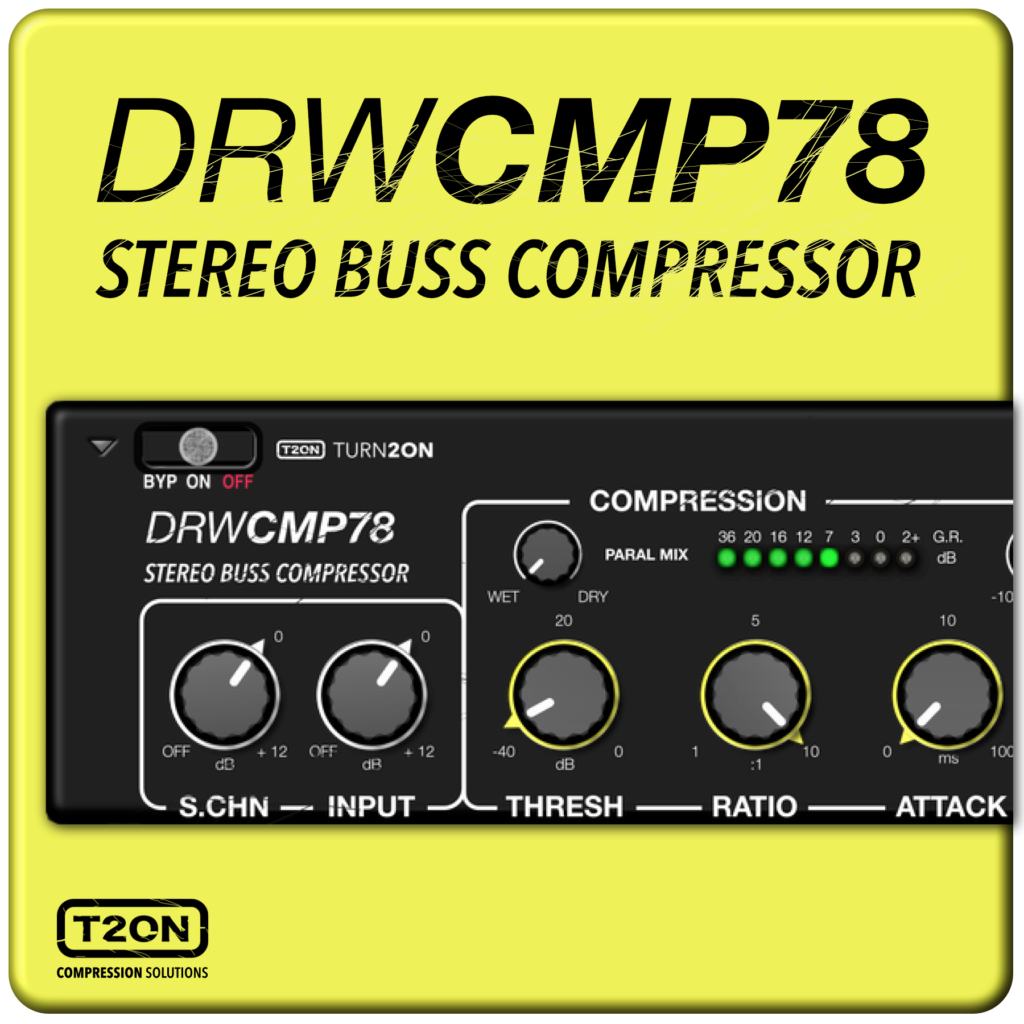DrwCmp78 Stereo Buss Compressor

DRWCMP78
STERO BUSS COMPRESSOR-
Intuitive Buss Compressor with Parallel mixing
-
Tonal Shape and Sidechain filtering control
-
Configurable character settings & distortion value

DRWCMP78 is a stereo buss compressor with character settings, controlled distortion, tonal shaping, parallel mixing, versalite, and intuitive. Inspired by the hardware effect processor Drawmer™ 1978®, but developed in its own way.
The compressor is an intuitive part of the device, with controllable Threshold, Ratio, Attack, Release, Parallel compression and level compensation settings.
Sidechain functionality is optional. LF and HF reduction responses control HP and LP filter activity in the sidechain to reduce or increase the response of high and low frequencies in compression processing.
Tonal shaping gives control over the frequency and level of filtering in the Low and High bands.
Saturation is a gradual distortion of the signal, an effect that can change the sound of your mix and tracks, adding a subtle form of distortion that adds harmonics to your signal.
Character settings give width and monogize effect control of the compressed signal.
Attack and Release curves help control parameter smoothness.
The compressor’s Parallel mix, and the main device Mix give complete control over the mix.
Try out DRWCMP78, the easy-to-use stereo buss compressor with configurable character settings, distortion value and shape control, which helps you find your favorite combination for the mix.
All product names, artists and bands names, trademarks, and registered trademarks are the property of their respective owners. All company, product, and service names used are for identification purposes only and are not intended to infringe on the copyrights of their respective owners. Use of these names, trademarks, brands, artists’ names does not imply any affiliation or cooperation with or endorsement by them with Turn2on. These product names and descriptions are provided for the sole purpose of identifying the tonal characteristics of specific products that were studied during the sound modeling process and for describing certain types of tones produced with current algorithms
Main Controls
Input Level: Controls the gain level of the incoming unprocessed (dry) signal
Sidechain Level: Controls the gain (modulation) level of the incoming control signal from the sidechain input
Threshold: Sets the audio level above which compression is applied
Ratio: Amount of gain reduction to apply; sets the degree of compression from 1:1 (no compression) to 4:1 (moderate compression), 8:1 (strong compression), 10:1 (approaching limiting)
Attack: Controls the reaction time it takes for gain reduction to increase when the signal level rises
Release: Controls the reaction time it takes for gain reduction to decrease when the signal level fails
Adjust Compensation: Adjust the output volume to compensate for any loss in level due to compression processing
Parallel Mix: Mixes wet (processed) compressor output signal with a dry (unprocessed) input signal. Helps to make parallel compression technique
LED Meter: Meter display shows the gain reduction level and compressor response time
Saturation Level: Sets the amount of drive (gradual distortion from subtle sweetening fx to gritty distortion), adding harmonic distortion to the band signal
Character Width: Adjust character of stereo width using a Mid/Side matrix (no effect on the mono signal)
Character Monogize: Frequency below which stereo width will be reduced to zero.
Attack Curve: Attack curve smoothing
Release Curve: Release curve smoothing
Engine Mode: Switch between the Envelope Detector Engine modes, how the envelope detector tracks the signal level.
– PUNCH: Follow the envelope below the threshold, which increases the attack punch as the envelope has further to come back up.
– FAST: Normal envelope detection with fast attack and release.
– SMOOTH: Release slows down as the signal falls below threshold.Shape LF: LF sets Low Frequency values in Shelf mode (60/125/250/350/500 Hz) or Bell mode (200/300/400 Hz) to Low band. Controls the pumping/ducking effect of the Low band.
LF Level: sets bass band-shaping control.Shape HF: HF sets High Frequency values in Bell mode (3/4/5/6 kHz) or Shelf mode (2/4/8/16 Hz) to High band.
HF Level: sets specific high band shaping contriol.LF/HF Reduction Response: HP & LP filters in the sidechain to reduce or increase response of High/Low frequencies
Mix: Switch between the default “Linear” and “Parallel” (each band includes dry/wet control) modes
Output Gain: Controls the gain level of the processed (wet) signal
Active FX: Switches the effect between Active and Soft-Bypass modes. Variation of effect bypass with fade in and fade out that excludes loud peaks when you enable or disable the effect



